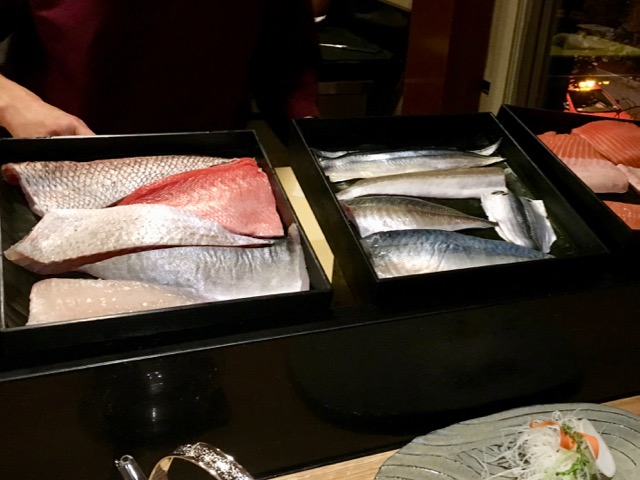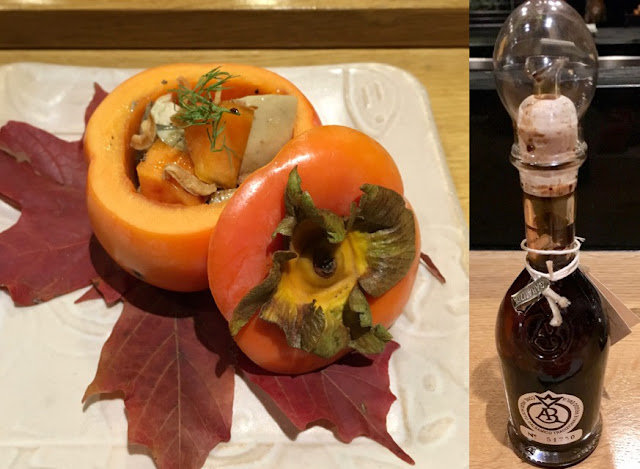Chef Masaya asked if we would like soba. We know he is passionate about soba and actually makes it by hand out of pure buckwheat flour which is extremely difficult. In turn, we are passionate about the results of his labor. We particularly remember the 100% buckwheat soba 十割蕎麦 that came with the last years Osechi box 御節箱. For this dinner he gave us a choice of warm or cold dipping sauce. After some indecision, I chose warm and my wife chose cold. I asked for only a small amount which, of course, Masaya knew without our asking.
While it took some time to prepare the soba, he served us a wonderful Japanese snow crab or "Zuwai-gani" ズワイガニ stuffed in it's own shell with roe or "uchiko" 内子 to share. This is a real delicacy harvested from the cold waters of the sea of Japan in winter. The last time, we visited "Maguro Ganchi" まぐろがんち(a restaurant specialized in "maguro" = tuna and "Ganchi" = crab in the local dialect) in Kanazawa, 金沢, we could not have zuwai-gani crab since it was out of season. I really should have taken a picture of Chef Masaya's crab dish but I was too busy enjoying it. This was served with a very special sauce; Jalapeno pepper infused soy sauce. We really liked this unique sauce. It had a nice fresh Jalapeno flavor without much heat, which went so well with the sweet succulent crab meat. My wife, who never in her life would have entertained the concept of imbibing soy sauce, in a surprise move upended the dipping dish and finished what remained in one draught-- it was that good. (I'm hoping Chef Masa was not looking).
Then came the soba in a shared portion. To our surprise, he served cold and hot dipping sauces for both of us. The cold sauce had nice "sudachi" すだちcitrus flavor and the hot sauce had a duck meat with the skin grilled and caramelized. It included grilled Tokyo scallion ("Kamonanba" 鴨南蛮 style). The soba had such a nice texture and fresh flavor. Both were excellent but I particularly liked kamo-nanban style dipping sauce. It was rich with tremendous umami. Once again my wife could not resist going for the sauce. With evident reluctance, however, she restrained herself from draining the bowl. We really appreciated tasting Chef Masaya's handmade soba.
At this point, we were quite full but when offered, who could refuse dessert? One was a very delicate green tea custard or "maccha purin" 抹茶プリン and the other was "anmitsu ice cream monaka" with shiratama 白玉餡蜜アイスクリーム最中. Again, I was too busy digging into the desserts to take pictures. I never got a snap of the maccha purin and as you can see in the picture below I remembered to take a picture of the ice cream monaka only after it was half finished. It was a clever hydrid of "monaka" (a very traditional Japanese sweet, light crunchy shell filled with sweetened red bean paste), "anmitsu" ("shiratma" 白玉 rice flour dumpling, sweet red bean paste with sweet sauce). This combination really worked. Despite our being so full at this point, we shared and finished both desserts without a problem.
As usual, we so enjoyed the evening. This is something which should be experienced at least once. But once we experienced it, we found we have to come back again and again. Every thing was exquisite. All the unique flavors remain as lasting taste memories; the unctuous taste of the chutoro, for example. All the chef's attention, details, seasonality, and new innovation without totally deviating from a classic Japanese cuisine are indeed worth much more than one Michelin star to us.















































